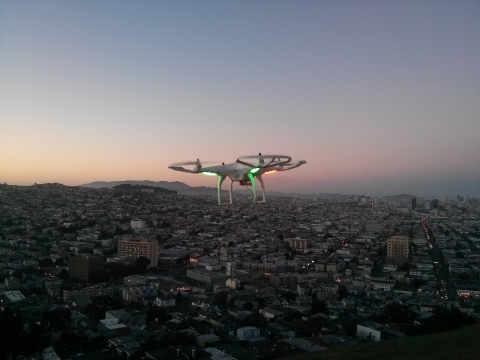
Drones are among the emerging technology innovations that are revolutionizing newsgathering. But these unmanned aerial vehicles (UAVs), first developed for military use, have been mired in controversy over their use by journalists.
Governments of a few countries have banned civilian use of drones outright, a blanket action that is sometimes aimed at preventing their use in newsgathering. Many countries, however, have not taken a definite position on the use of drones for civilian purposes, which leaves the door open to journalists in those countries for now.
While it is the most discussed, the potential for government actions prohibiting civilian use of drones is not the only concern when it comes to drone journalism. A meetup of journalists, technologists and programmers in Nigeria recently explored other issues around the use of drones for newsgathering and offered suggestions on how to address the possible challenges on this new front. Here are a few of our other concerns:
Cost of hardware acquisition/organizational support
Should governments allow journalists to use drones, the cost of acquiring the hardware will become the next concern since many media organizations are already struggling to stay profitable and may not be prepared to make additional financial outlays for buying UAVs.
The BYOD [buy your own drone] option is not likely to fly here considering the cost relative to the income of journalists in developing economies. A suggested solution is for media organizations to consider jointly acquiring high-quality drones and share the pictures and video feeds from deployments. On the other hand, organizations that go about it alone have the opportunity of selling compelling content that other media outlets without drones do not have.
Piloting skills
Journalists who want to cover news with drones will need the piloting skills to fly them and at the same time capture photos and video. There are hobbyists groups that could fill this need as well as a few startups that offer flying lessons for fees. Journalists interested in using drones for reporting can take lessons before their media organizations get the hardware. In this way, they can practice and get used to flying before actual deployment for news assignments.
Deciding what stories to cover
That childish excitement of getting a new toy could takeover when journalists have drones and the skills to fly them. Should every story now be covered with the new hardware? No. Media organizations have to develop in-house policies on when UAVs should be deployed for reporting.
For instance, drones are great tools when it is dangerous for the journalist to be physically present to cover a story, such as a protest that’s out of control or an environmental disaster where toxic fumes are being spewed. However, it is important to weigh the risk of flying a drone over a restive crowd during a protest; there is the danger of a crash or of angry protesters or riot police shooting the drone down and causing injury. The decision to use or not to use drones for covering a story should be made on a case-by-case basis.
Responding to restrictions
In countries that have outlawed the use of drones or restricted their use, reporters could only return to using them if the bans are lifted or legislation amended. Other countries that have not yet banned or restricted drones might be considering such action. One possible course for journalists is to team up with other UAV enthusiasts as a network that can present common positions and offer input regarding laws or proposed legislation.
Ethical considerations
An important question for journalists is whether the new capabilities offered by UAVs conform to traditional journalism ethics. The Professional Society of Drone Journalists has a code of ethics that is useful. The use of drones does not remove the time-tested ethical requirements of journalism but rather demands additional considerations.
The privacy of other citizens must be considered since drones can fly over areas where the reporter would not have been able to access. There is also security to consider involving airports, aircraft and military installations. Public safety is equally important; it takes only an instant for a drone to transform from a work tool to a dangerous object if it comes crashing into crowded area.
It is evident that more issues will surface as more drones take to the air. Journalists and news organizations must be prepared to address these issues as they emerge to ensure that drones are a useful and responsible tool for newsgathering.
Main image CC-licensed on Flickr via arbitragery